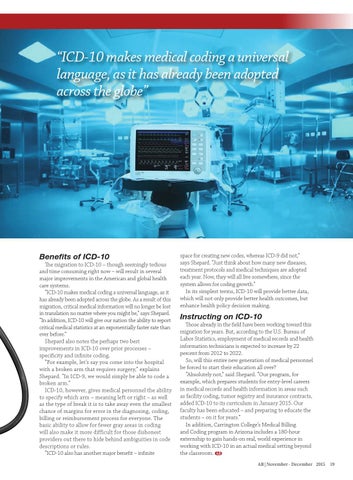“ICD-10 makes medical coding a universal language, as it has already been adopted across the globe”
Benefits of ICD-10 The migration to ICD-10 – though seemingly tedious and time consuming right now – will result in several major improvements in the American and global health care systems. “ICD-10 makes medical coding a universal language, as it has already been adopted across the globe. As a result of this migration, critical medical information will no longer be lost in translation no matter where you might be,” says Shepard. “In addition, ICD-10 will give our nation the ability to report critical medical statistics at an exponentially faster rate than ever before.” Shepard also notes the perhaps two best improvements in ICD-10 over prior processes – specificity and infinite coding. “For example, let’s say you come into the hospital with a broken arm that requires surgery,” explains Shepard. “In ICD-9, we would simply be able to code a broken arm.” ICD-10, however, gives medical personnel the ability to specify which arm – meaning left or right – as well as the type of break it is to take away even the smallest chance of margins for error in the diagnosing, coding, billing or reimbursement process for everyone. The basic ability to allow for fewer gray areas in coding will also make it more difficult for those dishonest providers out there to hide behind ambiguities in code descriptions or rules. “ICD-10 also has another major benefit – infinite
space for creating new codes, whereas ICD-9 did not,” says Shepard. “Just think about how many new diseases, treatment protocols and medical techniques are adopted each year. Now, they will all live somewhere, since the system allows for coding growth.” In its simplest terms, ICD-10 will provide better data, which will not only provide better health outcomes, but enhance health policy decision making.
Instructing on ICD-10 Those already in the field have been working toward this migration for years. But, according to the U.S. Bureau of Labor Statistics, employment of medical records and health information technicians is expected to increase by 22 percent from 2012 to 2022. So, will this entire new generation of medical personnel be forced to start their education all over? “Absolutely not,” said Shepard. “Our program, for example, which prepares students for entry-level careers in medical records and health information in areas such as facility coding, tumor registry and insurance contracts, added ICD-10 to its curriculum in January 2015. Our faculty has been educated – and preparing to educate the students – on it for years.” In addition, Carrington College’s Medical Billing and Coding program in Arizona includes a 180-hour externship to gain hands-on real, world experience in working with ICD-10 in an actual medical setting beyond the classroom. AB | November - December 2015
19
